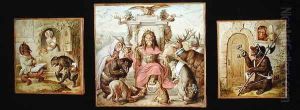Ludwig Weisser Paintings
Ludwig Weisser was a German painter and sculptor born in 1928. His artistic journey began in post-World War II Germany, a period marked by a quest for new beginnings and expressions in art. Weisser's work, deeply influenced by the historical and cultural upheavals of his time, navigated between abstraction and figuration, exploring themes of human existence, spirituality, and the natural world.
Weisser studied at the Academy of Fine Arts in Stuttgart, where he was exposed to a wide range of artistic theories and practices. This education laid the foundation for his experimental approach to materials and form. Throughout the 1950s and 1960s, his work evolved in response to the dominant art movements of the time, including Abstract Expressionism and Art Informel, yet he always maintained a distinctive, personal style that resisted easy categorization.
In addition to his painting, Weisser was renowned for his sculptural works. He experimented with various materials, including bronze, stone, and wood, creating pieces that often integrated kinetic elements or played with the balance between solidity and movement. His sculptures, like his paintings, were deeply rooted in philosophical and metaphysical questions, reflecting his lifelong interest in Eastern philosophies and the human condition.
Weisser's contributions to art were recognized with several awards and exhibitions throughout Europe. Despite this, he remained somewhat outside the mainstream art world, dedicating himself to his work with a quiet intensity. His studio in Stuttgart became a meeting place for artists, philosophers, and writers, where ideas were exchanged in an atmosphere of creativity and intellectual freedom.
Ludwig Weisser passed away in 2017, leaving behind a body of work that continues to be appreciated for its depth, originality, and the artist's unyielding pursuit of authenticity. His legacy is preserved in collections and museums across Germany and internationally, where his art continues to inspire and provoke thought among new generations of artists and art lovers.
